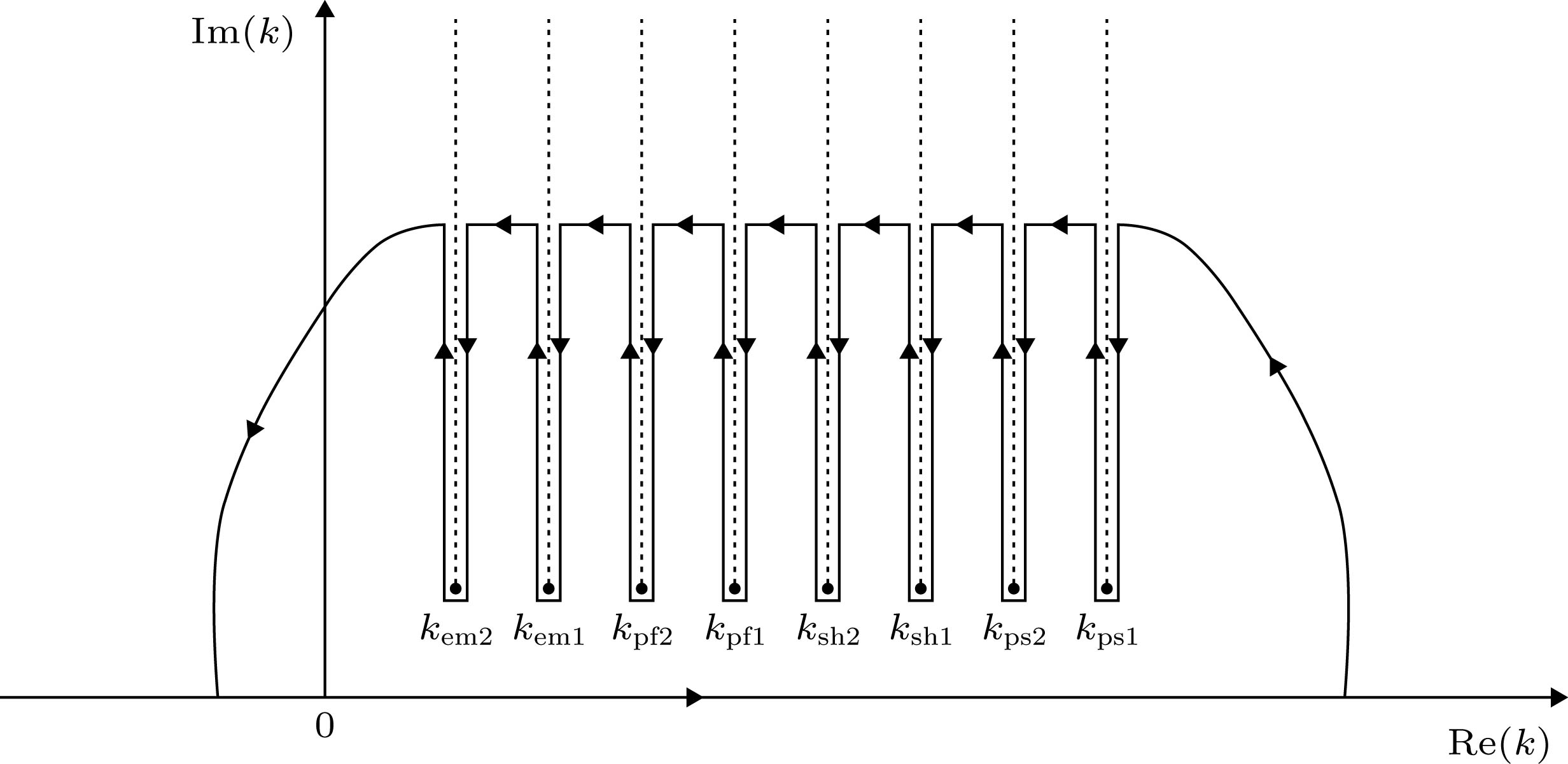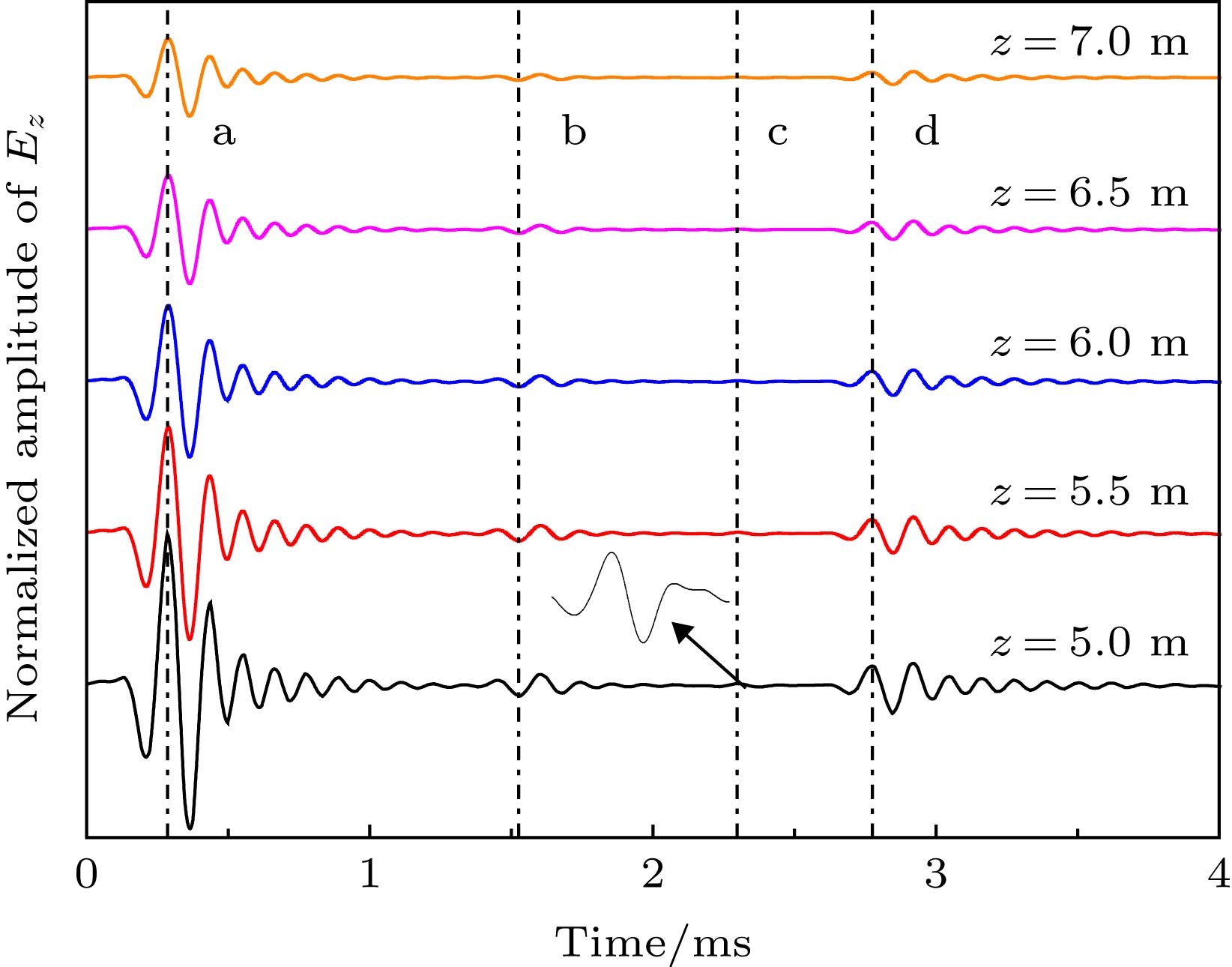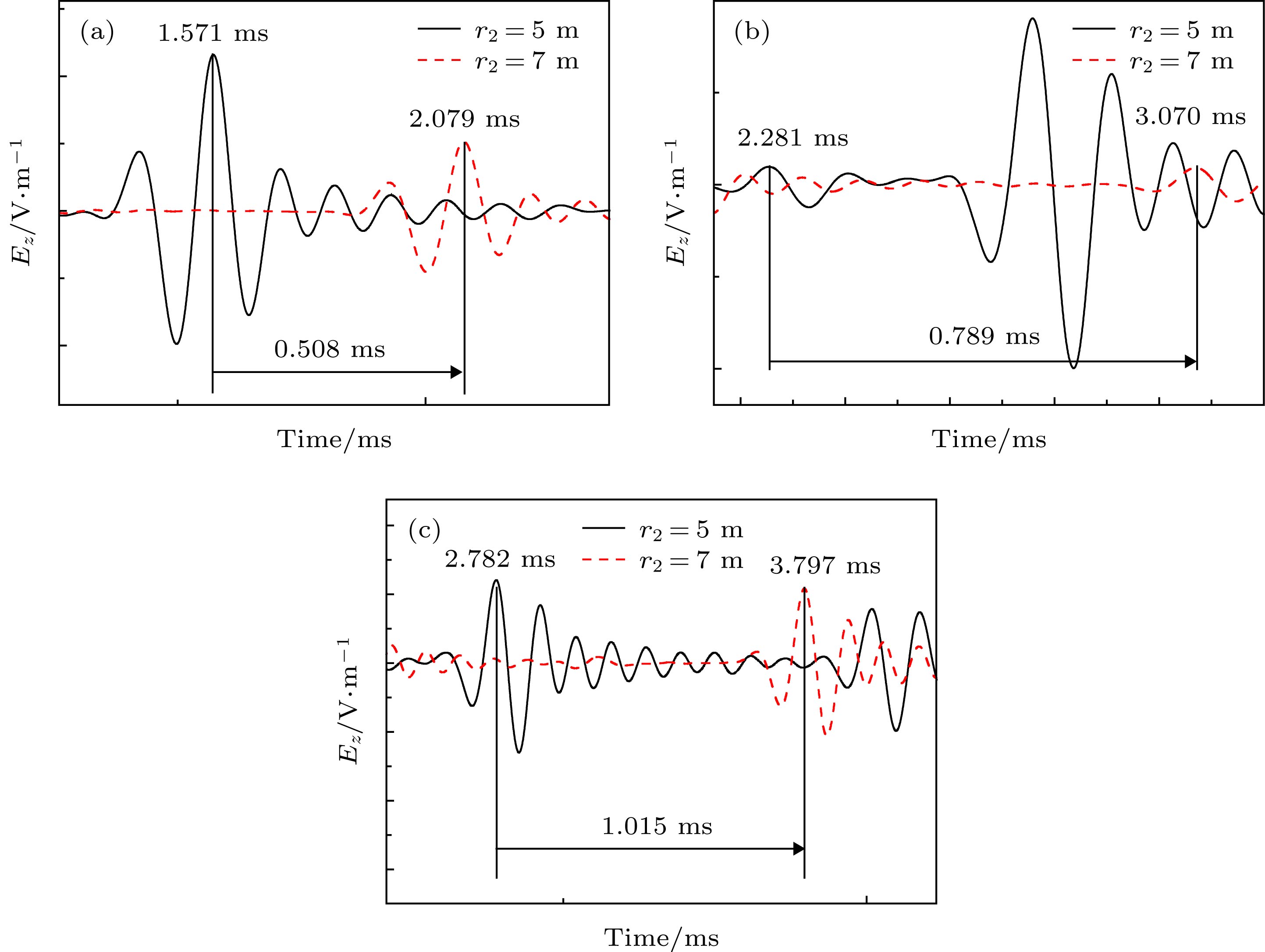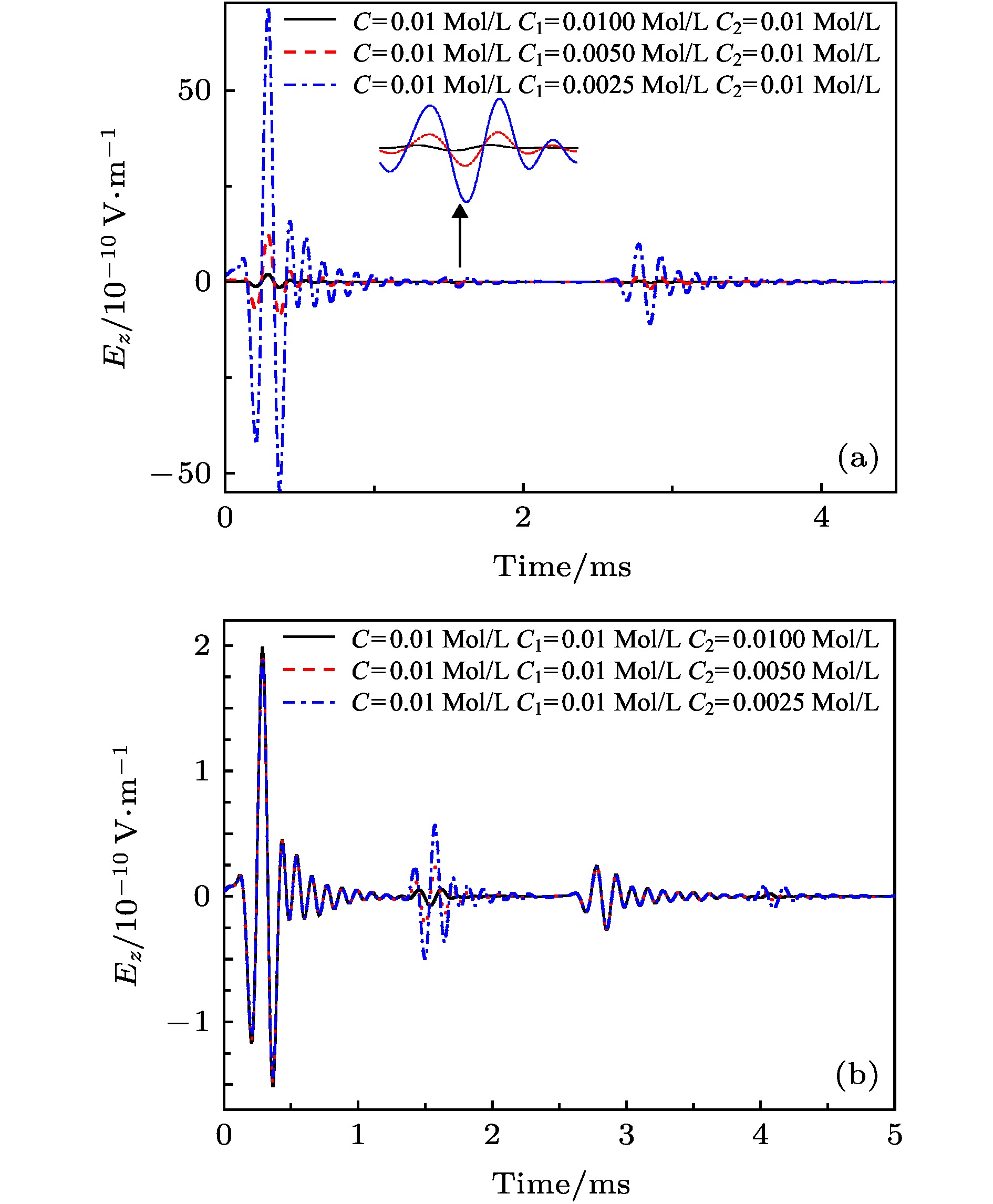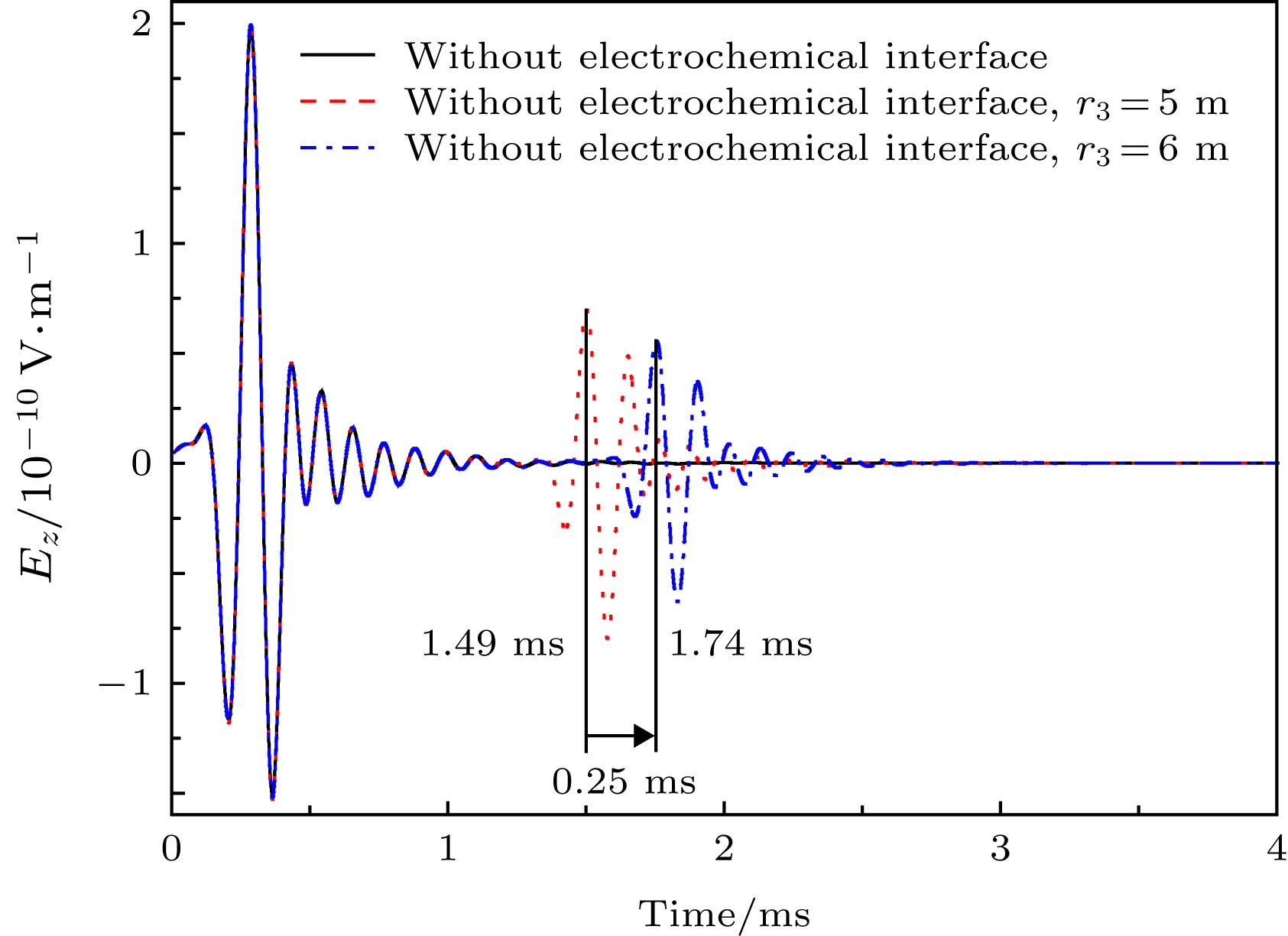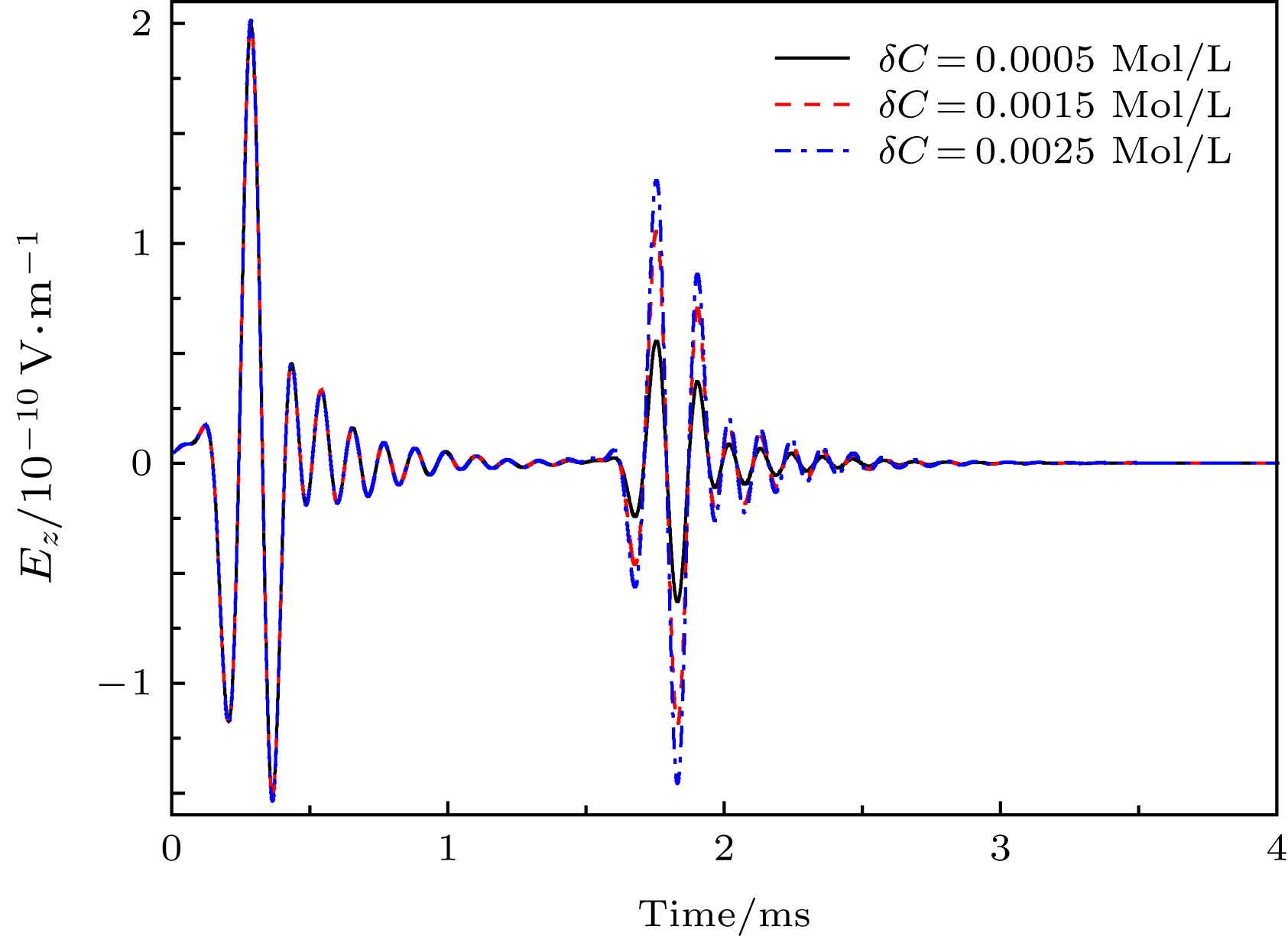-
声波在含流体孔隙介质内传播的过程当中, 会产生耦合电磁波, 根据这一现象前人提出了声电效应测井的方法. 本文探究了井外为柱状双层孔隙地层声电效应测井耦合声电场的产生机理和传播规律. 通过计算电场支点的垂直割线积分, 得到以地层电磁波速度传播的界面转换电磁波. 对比不同夹层孔隙介质层厚的界面转换电磁波时域波形, 可以发现每一次地层纵、横波传播至界面发生折反射时, 都会产生界面转换电磁波, 这些成分构成了界面转换电磁波的总响应. 考察了孔隙介质流体矿化度对界面转换电磁波的影响, 发现当介质分界面两侧孔隙介质流体矿化度差异越大时, 界面转换电磁波的幅度越大, 且两个界面所产生的电磁波互不影响. 同时考察了仅存在矿化度界面的情况, 发现声波传播至矿化度界面处也会产生界面转换电磁波, 可以利用这一特性来探测井外介质电化学界面的位置. 研究界面转换电磁波对于认识柱状双层孔隙地层声电效应测井的界面响应规律具有重要意义.In recent years, electrokinetic effect has received wide attention. The electrokinetic effect refers to the coupling and conversion of acoustic waves and electromagnetic waves in a porous medium. Due to the electric double layer structure of porous medium, electromagnetic waves are generated during acoustic waves propagation in the liquid-containing porous medium. Based on this phenomenon, one proposes a method for electrokinetic effect logging.The electrokinetic effect has great application prospects in earthquake prediction and engineering exploration. The generation mechanism and propagation law of acoustic-electric coupling wave in electrokinetic effect logging of double-cylindrical-layer porous medium are explored in this paper. By calculating the vertical secant integral of the electric field branch point, the total response of the interface converted electromagnetic wave can be obtained. Previously, in the cylindrical layered medium, the secant integral corresponding to the borehole fluid and the inner layer medium branch point is zero. So the examples in this paper are calculated from the vertical secant integral of branch point kem2, which corresponds to the outermost infinite medium. It is found that when each time the longitudinal and transverse waves of the formation propagate to the interface, the interface converted electromagnetic waves are generated. These converted electromagnetic waves constitute the total response of the interface converted electromagnetic wave. At the same time, the influence of porous medium fluid salinity on interface converted electromagnetic wave is investigated. It is found that when only the inner layer porous medium fluid salinity changes, the amplitude of the interface converted electromagnetic wave response of the two interfaces is affected. When only the salinity of the outermost porous medium fluid changes, only the amplitude of the interface converted electromagnetic wave generated at the second interface is affected, but the interface electromagnetic waves generated at the internal interface are not influenced. When the difference in pore fluid salinity between both sides of the medium interface is larger, the amplitude of the interface converted electromagnetic wave is greater and the electromagnetic waves generated from the two interfaces are independent of each other.The case where fluid intrusion zone in porous medium is investigated, and the generation mechanism of interface converted electromagnetic wave is also studied when only a mineralization interface exists. It is found that the converted electric field is also generated when the acoustic waves propagates to the salinity interface. Since there exists neither multiple refraction of acoustic wave nor reflection of acoustic wave in the porous medium, the interface electromagnetic wave has only two wave packets, which are interface converted electromagnetic waves generated respectively at the borehole wall and at the electrochemical interface.The interface converted electromagnetic wave can be used to detect the location of the medium interface and the salinity interface. It can also clearly reflect the refraction and reflection law of wave propagating in stratified porous medium, which is of great significance for understanding the interface response mechanism of double-cylindrical-layer porous medium in electrokinetic effect logging.
-
Keywords:
- electrokinetic effect /
- porous formation /
- secant integral /
- interface converted electromagnetic wave
[1] Pride S R 1994 Phys. Rev. B 50 15678
 Google Scholar
Google Scholar
[2] Zhu Z, Haartsen M W, Toksöz 1999 Geophysics 64 1349
 Google Scholar
Google Scholar
[3] 胡恒山, 王克协 1999 测井技术 23 427
 Google Scholar
Google Scholar
Hu H S, Wang K X 1999 WLT 23 427
 Google Scholar
Google Scholar
[4] 胡恒山, 王克协 2000 测井技术 24 3
 Google Scholar
Google Scholar
Hu H S, Wang K X 2000 WLT 24 3
 Google Scholar
Google Scholar
[5] Santos J E, Savioli G B 2015 J. Acoust. Soc. Am. 138 3033
 Google Scholar
Google Scholar
[6] Jardani A, Revil A 2015 Geophys. J. Int. 202 850
 Google Scholar
Google Scholar
[7] Liu Y K, Smeulders D, Su Y D 2018 J. Acoust. Soc. Am. 143 EL13
 Google Scholar
Google Scholar
[8] Thompson A H, Gist G A 1993 Lead. Edge. 12 1169
 Google Scholar
Google Scholar
[9] 段文星, 鞠晓东, 卢俊强, 门百永, 车小花, 乔文孝 2017 石油科学通报 2 24
 Google Scholar
Google Scholar
Duan W X, Ju X D, Lu J Q, Men B Y, Che X H, Qiao W X 2017 Petroleum Science Bulletin 2 24
 Google Scholar
Google Scholar
[10] 关威, 陈达, 王军, 胡恒山 2019 应用声学 38 142
 Google Scholar
Google Scholar
Guan W, Chen D, Wang J, Hu H S 2019 J. Appl. Acoust. 38 142
 Google Scholar
Google Scholar
[11] Butler K E, Russell R D, Kepic A W, Maxwell M 1996 Geophys. 61 1769
 Google Scholar
Google Scholar
[12] Zhu Z, Toksöz M N 2003 Geophysics 68 1519
 Google Scholar
Google Scholar
[13] Zhu Z, Toksöz M N 2005 Geophysics 70 F45
 Google Scholar
Google Scholar
[14] Biot M A 1956 J. Acoust. Soc. Am. 28 168
 Google Scholar
Google Scholar
[15] Biot M A 1956 J. Acoust. Soc. Am. 28 178
[16] 胡恒山, 刘家琦, 王洪滨, 王克协 2003 地球物理学报 46 259
 Google Scholar
Google Scholar
Hu H S, Liu J Q, Wang H B, Wang K X 2003 Chin. J. Geophys. 46 259
 Google Scholar
Google Scholar
[17] Guan W, Shi P, Hu H S 2018 Geophys. J. Int. 212 458
 Google Scholar
Google Scholar
[18] Gao W Y, Cui Z W, Wang K X 2013 J. Sound Vib. 332 5014
[19] Guan W, Hu H S 2008 J. Comput. Phys. 227 5633
 Google Scholar
Google Scholar
[20] 关威, 姚泽鑫, 胡恒山 2017 地球物理学报 60 4516
 Google Scholar
Google Scholar
Guan W, Yao Z X, Hu H S 2017 Chin. J. Geophys. 60 4516
 Google Scholar
Google Scholar
[21] 崔志文 2004 博士学位论文 (长春: 吉林大学)
Cui Z W 2004 Ph. D. Dissertation (Changchun: Jilin University) (in Chinese)
[22] 丁浩然, 崔志文, 吕伟国, 刘金霞, 王克协 2016 地球物理学报 59 3524
 Google Scholar
Google Scholar
Ding H R, Cui Z W, Lv W G, Liu J X, Wang K X 2016 Chin. J. Geophys. 59 3524
 Google Scholar
Google Scholar
[23] Ding H R, Liu J X, Cui Z W, Kundu T 2017 Chin. Phys. B 26 349
 Google Scholar
Google Scholar
[24] 赵永吉, 丁浩然, 崔志文, 王克协 2016 声学技术 35 258
Zhao Y J, Ding H R, Cui Z W, Wang K X 2016 Tech. Acoust. 35 258
[25] Wang J, Hu H S, Guan W 2015 Geophys. J. Int. 203 1937
 Google Scholar
Google Scholar
[26] 王军, 胡恒山, 关威, Zhenya Zhu 2016 地球物理学报 59 381
 Google Scholar
Google Scholar
Wang J, Hu H S, Guan W, Zhu Z 2016 Chin. J. Geophys. 59 381
 Google Scholar
Google Scholar
[27] Peng R, Wei J X, Di B R, Ding P B, Liu Z C 2017 Geophys. J. Int. 210 1703
 Google Scholar
Google Scholar
[28] Lu J Q, Ju X D, Men B Y 2017 J. Geophys. Eng. 14 397
 Google Scholar
Google Scholar
[29] 胡恒山 2003 物理学报 52 1954
 Google Scholar
Google Scholar
Hu H S 2003 Acta Phys. Sin. 52 1954
 Google Scholar
Google Scholar
[30] Hu H S, Guan W, Wang K X (Abousleiman Y N, Cheng A H D, Ulm F J ed.) 2005 PoromechanicsIII: Biot Centennial (1905-2005) (London: A. A. Balkema Publishers) p593
[31] 王治, 胡恒山, 关威, 何晓 2012 物理学报 61 054302
 Google Scholar
Google Scholar
Wang Z, Hu H S, Guan W, He X 2012 Acta Phys. Sin. 61 054302
 Google Scholar
Google Scholar
[32] Guan W, Hu H S, Wang Z 2013 Geophys. Prospect. 61 120
 Google Scholar
Google Scholar
[33] Guan W, Yin C G, Hu H S 2015 Geophys. J. Int. 203 2277
 Google Scholar
Google Scholar
[34] Pride S R, Harrtsen M W 1996 J. Acoust. Soc. Am. 100 1301
 Google Scholar
Google Scholar
[35] Kurkjian A L 1985 Geophysics 50 852
 Google Scholar
Google Scholar
[36] Chew WC 1983 IEEE 31 653
[37] 李清亮, 潘威炎 1993 电波科学学报 8 37
Li Q L, Pan W Y 1993 Chin. J. Radi. Sci. 8 37
-
图 4 双层介质与单层无限大介质声电测井界面转换电磁波波形对比 (a)孔隙介质1与单层无限大介质参数一致时的界面转换电磁波; (b)双层介质退化为单层介质时的界面转换电磁波(实线对应单层无限大介质, 虚线对应双层介质)
Fig. 4. Comparison of electrokinetic logging interface converted electromagnetic wave waveforms between two-layer medium and single-layer infinite medium: (a) Interface converted electromagnetic waveform when porous medium 1 parameters are consistent with single layer infinite medium; (b) interface converted electromagnetic wave when double-layer medium degenerates into single-layer medium (the solid line corresponds to the single-layer infinite medium, the dashed line corresponds to the double-layer medium).
图 6 界面转换电磁波不同成分到时差 (a)成分b; (b)成分c; (c)成分d (实线和虚线分别对应夹层介质层厚5和7 m)
Fig. 6. Arrival time difference of different components of the interface converted electromagnetic wave: (a) Component b; (b) component c; (c) component d (the solid and dashed lines correspond to the interlayer medium thickness of 5 m and 7 m, respectively).
图 7 不同孔隙介质流体矿化度下的界面转换电磁波波形(a)不同夹层孔隙介质流体矿化度的界面转换电磁波波形(实线, 虚线, 点划线分别对应夹层孔隙介质流体矿化度C1 = 0.01, 0.005, 0.0025 mol/L); (b)不同最外层孔隙介质流体矿化度的界面转换电磁波波形(实线, 虚线, 点划线分别对应最外层孔隙介质流体矿化度C2 = 0.01, 0.005, 0.0025 mol/L)
Fig. 7. Interface converted electromagnetic wave waveforms under different porous medium fluid salinity: (a) Interface converted electromagnetic wave waveforms of different interlayer porous medium fluid salinity (solid line, dashed line, dash-dotted line corresponding to interlayer porous medium fluid salinity C1 = 0.01, 0.005, 0.0025 mol/L respectively); (b) interface converted electromagnetic wave waveforms of different outermost porous medium fluid salinity (solid line, dashed line, dash-dotted line corresponding to outermost porous medium fluid salinity C2 = 0.01, 0.005, 0.0025 mol/Lrespectively).
图 8 不同矿化度界面位置的界面转换电磁波波形对比(实线对应不存在矿化度界面时的界面转换电磁波, 虚线和点划线分别对应矿化度界面距离井壁5 m和6 m时的界面转换电磁波)
Fig. 8. Waveform comparison of interface converted electromagnetic wave waveforms of different salinity interface position (the solid line corresponds to the interface converted electromagnetic wave when there is no salinity interface, the dashed line and the dash-dotted line respectively correspond to the interface converted electromagnetic waves when the salinity interface is 5 m and 6 m away from the well wall).
图 9 矿化度差异对界面转换电磁波的影响(实线, 虚线和点划线分别对应矿化度差异为
${\text{δ}} C =$ 0.0005, 0.0015, 0.0025 mol/L)Fig. 9. Effect of salinity difference on interface converted electromagnetic waves (the solid line, the dashed line and the dash-dotted line respectively correspond to the salinity difference of
${\text{δ}} C=$ 0.0005, 0.0015, 0.0025 mol/L).表 1 孔隙介质和井内流体参数
Table 1. Porous medium and borehole fluid parameters.
参数 孔隙
介质1孔隙
介质2井内
流体孔隙度$\phi $ 0.2 0.2 — 渗透率κ0/μm2 1.0 1.0 — 弯曲度${\alpha _\infty }$ 3.0 3.0 — 骨架压缩模量${K_{\rm{b} } }/10^9{\rm{Pa} }$ 14.39 2.61 — 介质剪切模量${G_{\rm{b} } }/10^9{\rm{Pa} }$ 13.99 2.83 — 介质密度$\rho /{\rm{kg} } \cdot { {\rm{m} }^3}$ 2650 2650 1000 基质体积弹性模量${K_{\rm{s} } }/10^9{\rm{Pa} }$ 35.79 33.40 — 流体体积弹性模量${K_{\rm{f} } }/10^9{\rm{Pa} }$ 2.25 2.25 2.25 矿化度$C/{\rm{mol} } \cdot { {\rm{L} }^{ - 1} }$ 0.01 0.01 0.01 流体介电常数${\varepsilon _{\rm{f}}}/{{\rm{\varepsilon}} _0}$ 80 80 80 -
[1] Pride S R 1994 Phys. Rev. B 50 15678
 Google Scholar
Google Scholar
[2] Zhu Z, Haartsen M W, Toksöz 1999 Geophysics 64 1349
 Google Scholar
Google Scholar
[3] 胡恒山, 王克协 1999 测井技术 23 427
 Google Scholar
Google Scholar
Hu H S, Wang K X 1999 WLT 23 427
 Google Scholar
Google Scholar
[4] 胡恒山, 王克协 2000 测井技术 24 3
 Google Scholar
Google Scholar
Hu H S, Wang K X 2000 WLT 24 3
 Google Scholar
Google Scholar
[5] Santos J E, Savioli G B 2015 J. Acoust. Soc. Am. 138 3033
 Google Scholar
Google Scholar
[6] Jardani A, Revil A 2015 Geophys. J. Int. 202 850
 Google Scholar
Google Scholar
[7] Liu Y K, Smeulders D, Su Y D 2018 J. Acoust. Soc. Am. 143 EL13
 Google Scholar
Google Scholar
[8] Thompson A H, Gist G A 1993 Lead. Edge. 12 1169
 Google Scholar
Google Scholar
[9] 段文星, 鞠晓东, 卢俊强, 门百永, 车小花, 乔文孝 2017 石油科学通报 2 24
 Google Scholar
Google Scholar
Duan W X, Ju X D, Lu J Q, Men B Y, Che X H, Qiao W X 2017 Petroleum Science Bulletin 2 24
 Google Scholar
Google Scholar
[10] 关威, 陈达, 王军, 胡恒山 2019 应用声学 38 142
 Google Scholar
Google Scholar
Guan W, Chen D, Wang J, Hu H S 2019 J. Appl. Acoust. 38 142
 Google Scholar
Google Scholar
[11] Butler K E, Russell R D, Kepic A W, Maxwell M 1996 Geophys. 61 1769
 Google Scholar
Google Scholar
[12] Zhu Z, Toksöz M N 2003 Geophysics 68 1519
 Google Scholar
Google Scholar
[13] Zhu Z, Toksöz M N 2005 Geophysics 70 F45
 Google Scholar
Google Scholar
[14] Biot M A 1956 J. Acoust. Soc. Am. 28 168
 Google Scholar
Google Scholar
[15] Biot M A 1956 J. Acoust. Soc. Am. 28 178
[16] 胡恒山, 刘家琦, 王洪滨, 王克协 2003 地球物理学报 46 259
 Google Scholar
Google Scholar
Hu H S, Liu J Q, Wang H B, Wang K X 2003 Chin. J. Geophys. 46 259
 Google Scholar
Google Scholar
[17] Guan W, Shi P, Hu H S 2018 Geophys. J. Int. 212 458
 Google Scholar
Google Scholar
[18] Gao W Y, Cui Z W, Wang K X 2013 J. Sound Vib. 332 5014
[19] Guan W, Hu H S 2008 J. Comput. Phys. 227 5633
 Google Scholar
Google Scholar
[20] 关威, 姚泽鑫, 胡恒山 2017 地球物理学报 60 4516
 Google Scholar
Google Scholar
Guan W, Yao Z X, Hu H S 2017 Chin. J. Geophys. 60 4516
 Google Scholar
Google Scholar
[21] 崔志文 2004 博士学位论文 (长春: 吉林大学)
Cui Z W 2004 Ph. D. Dissertation (Changchun: Jilin University) (in Chinese)
[22] 丁浩然, 崔志文, 吕伟国, 刘金霞, 王克协 2016 地球物理学报 59 3524
 Google Scholar
Google Scholar
Ding H R, Cui Z W, Lv W G, Liu J X, Wang K X 2016 Chin. J. Geophys. 59 3524
 Google Scholar
Google Scholar
[23] Ding H R, Liu J X, Cui Z W, Kundu T 2017 Chin. Phys. B 26 349
 Google Scholar
Google Scholar
[24] 赵永吉, 丁浩然, 崔志文, 王克协 2016 声学技术 35 258
Zhao Y J, Ding H R, Cui Z W, Wang K X 2016 Tech. Acoust. 35 258
[25] Wang J, Hu H S, Guan W 2015 Geophys. J. Int. 203 1937
 Google Scholar
Google Scholar
[26] 王军, 胡恒山, 关威, Zhenya Zhu 2016 地球物理学报 59 381
 Google Scholar
Google Scholar
Wang J, Hu H S, Guan W, Zhu Z 2016 Chin. J. Geophys. 59 381
 Google Scholar
Google Scholar
[27] Peng R, Wei J X, Di B R, Ding P B, Liu Z C 2017 Geophys. J. Int. 210 1703
 Google Scholar
Google Scholar
[28] Lu J Q, Ju X D, Men B Y 2017 J. Geophys. Eng. 14 397
 Google Scholar
Google Scholar
[29] 胡恒山 2003 物理学报 52 1954
 Google Scholar
Google Scholar
Hu H S 2003 Acta Phys. Sin. 52 1954
 Google Scholar
Google Scholar
[30] Hu H S, Guan W, Wang K X (Abousleiman Y N, Cheng A H D, Ulm F J ed.) 2005 PoromechanicsIII: Biot Centennial (1905-2005) (London: A. A. Balkema Publishers) p593
[31] 王治, 胡恒山, 关威, 何晓 2012 物理学报 61 054302
 Google Scholar
Google Scholar
Wang Z, Hu H S, Guan W, He X 2012 Acta Phys. Sin. 61 054302
 Google Scholar
Google Scholar
[32] Guan W, Hu H S, Wang Z 2013 Geophys. Prospect. 61 120
 Google Scholar
Google Scholar
[33] Guan W, Yin C G, Hu H S 2015 Geophys. J. Int. 203 2277
 Google Scholar
Google Scholar
[34] Pride S R, Harrtsen M W 1996 J. Acoust. Soc. Am. 100 1301
 Google Scholar
Google Scholar
[35] Kurkjian A L 1985 Geophysics 50 852
 Google Scholar
Google Scholar
[36] Chew WC 1983 IEEE 31 653
[37] 李清亮, 潘威炎 1993 电波科学学报 8 37
Li Q L, Pan W Y 1993 Chin. J. Radi. Sci. 8 37
计量
- 文章访问数: 11642
- PDF下载量: 61
- 被引次数: 0














 下载:
下载:
